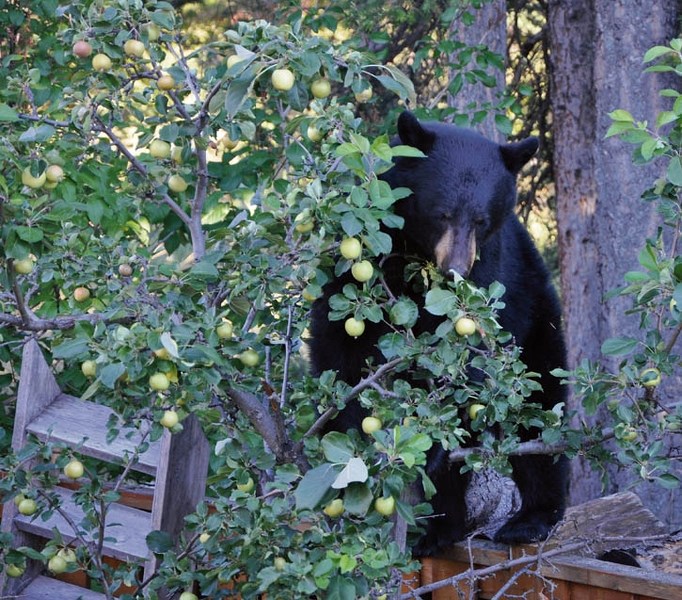BANFF – Stricter changes to the Town’s community standards bylaw could see fruit-bearing trees or shrubs in Banff uprooted if observed to have been fed upon by wildlife and to pose a risk to the animal or the public.
The amendment, which passed all three readings of council at its August meeting, aims to strengthen and clarify the Town’s approach to managing wildlife attractants, particularly fruit trees, which can draw hungry bears and other animals into town.
“We need to be able to have the teeth to order the removal [of a tree] if it comes to that,” said Banff Mayor Corrie DiManno. “Living in a national park setting, we are proud stewards of this land and that means protecting the wildlife that live here among us.
“It is really important that we do everything we can to mitigate any situation that could put wildlife or humans at risk.”
The bylaw authorizes the municipality to require homeowners to clear fruit from trees or the ground to discourage animals from entering the national park townsite, but new language also reinforces officers can issue an order to remove fruit from the tree if that isn’t followed. Failing compliance with that, or if a bylaw contravention resulted in harmful impacts to wildlife or members of the public, a court order to remove the tree or shrub could follow.
“Basically, it’s making it very clear that if that happens the Town may, at its discretion, come in and order the removal of that tree or shrub,” said Michael Hay, manager of environmental services with the Town of Banff.
Hay said this enforcement would be carried out with an education-first approach, assisted by a door-knocking campaign between Parks Canada and the Town to raise awareness in August. This involved officials visiting all properties with identified crabapple trees to engage with residents and business owners and leave informative door hangers about fruit tree management in Banff.
A staff report stated at least 25 properties in the townsite have crabapple trees.
The door-knocking campaign also reminds those with fruit trees on their properties of the Town-led fruit tree removal program, offering 100 per cent reimbursement costs that come with removal and replacement.
“Part of our education, and even in the order to remedy scenario, would be to advise them that all you gotta do is pick up the phone, let us know you’re gonna remove the tree, and we’ll pay for it,” said Hay.
“We have a replacement program that pays for all of this so there aren’t too many reasons not to do it.”
According to Town staff, 102 incidents have been reported of wildlife getting into garbage, food waste, recyclables and fruit trees since 2019.
In the past, a black bear was killed in 2014 when it continued to eat crab apples from a property. Grizzly bear 148 was also shot dead by a hunter in British Columbia after it was relocated from Canmore and had spent much of her time eating apples in the Banff townsite.
Last fall, two bears were also killed by Parks Canada when they continued to eat crabapples in the townsite in areas like the industrial compound, downtown core and Middle Springs.
Hay said the tree in the industrial compound was removed voluntarily by the property owner, but the others remain.
Between 2015 and 2017, the Town and Parks Canada jointly led a program that removed around 28 crabapple trees from 21 private properties. The Town reports that, despite the reimbursement program, there haven’t been any proactive removals of fruit trees in recent years.
The Town of Canmore has a similar bylaw that prohibits fruit from trees or shrubs from accumulating on branches or on the ground. Last month, the Town cut down six fruit trees on municipally-owned lands in a bid to encourage more residents to buy in to its removal incentive program.
About 50 trees have been removed in Canmore this year, so far. However, a survey in 2018 identified there are about 2,500 fruit trees town-wide.
One of the key recommendations of the 2018 Bow Valley Human-Wildlife Coexistence report is to improve the management and prevention of wildlife attractants and hiding cover in Bow Valley communities.
DiManno said it’s important the Town of Banff continue advancing the goals of the human-wildlife coexistence report and the guidance given.
“We know that we still have some properties that haven’t participated in our replacement program. It’s unfortunate, it’s been about five years I think since we’ve had any uptake, so to me this is vitally important to add to our toolbox,” said DiManno of the amended bylaw.
“We’ve got to walk the talk here and reduce any problem trees that we have in town.”
The amended bylaw also requires residents and business owners to prevent wildlife from using spaces or outdoor structures, like decks or sheds for hiding or refuge.
In Banff, there have been cases of cougars hiding under decks and last year, a coyote pair denned under a backyard shed, where they had seven pups.
Failure to comply with removing hiding spaces for wildlife will evoke a similar response from officers as failure to remove wildlife attractants and the occupier or owner of the premises will be ordered to block access to the space for wildlife.
Council has also been looking at an amendment to the Town’s design guidelines, which would prohibit the planting of trees and shrubs such as crabapple, cherry tree and mountain ash varieties, all of which pose a significant wildlife attractant risk.
“Town of Banff legal counsel clarified that the Town can lawfully require property owners and occupiers to manage fruit-bearing trees and shrubs to not create animal attractants,” states a staff report.
Although the Town has not yet done so, amendments to its land use bylaw and design guidelines would be required to make the change.
The Local Journalism Initiative is funded by the Government of Canada. The position covers Îyârhe (Stoney) Nakoda First Nation and Kananaskis Country.



